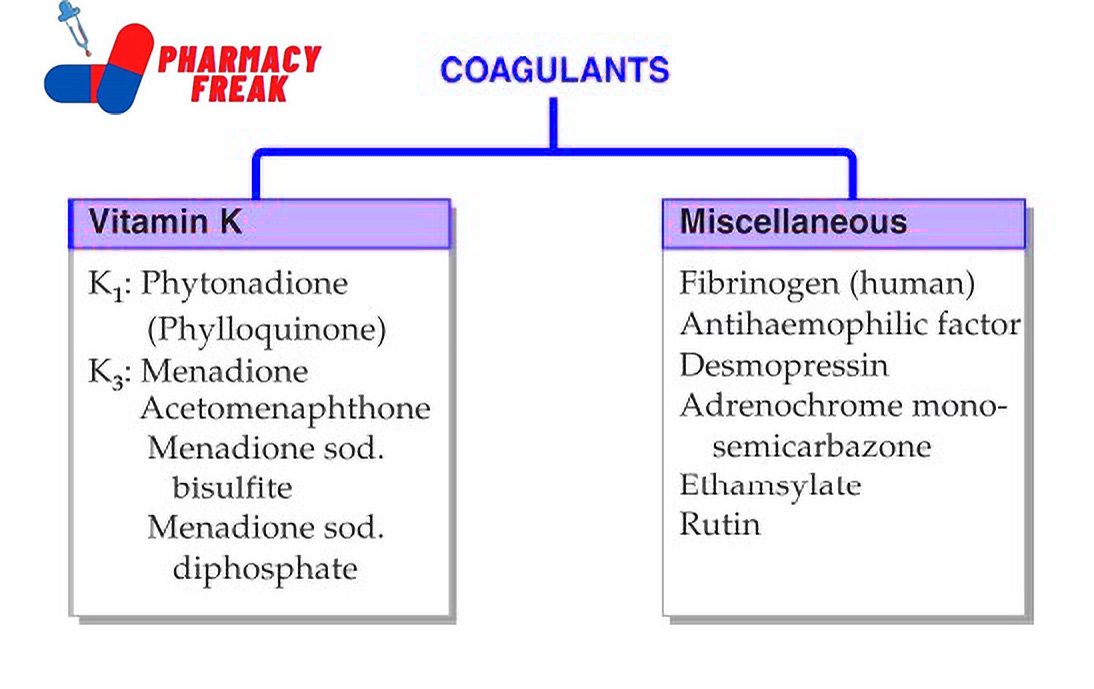Coagulants are agents used to promote blood clotting in cases of bleeding disorders or excessive anticoagulation. They are used in various clinical settings including surgery, trauma, hemophilia, liver disease, and anticoagulant overdose. These drugs act by either supplying deficient clotting factors or enhancing the natural clotting process.
This blog from Pharmacy Freak outlines the classification, mechanisms, clinical applications, drug of choice highlights, side effects, and key treatment insights based on standard pharmacological references.
Table of Contents
What is Coagulants
Coagulants are agents that promote hemostasis by accelerating the coagulation cascade or replacing deficient clotting factors. They are used to stop or prevent bleeding in both congenital and acquired conditions.
Classification of Coagulants (KD Tripathi)
- Vitamin K
– K₁: Phytonadione (Phylloquinone)
– K₃: Menadione, Acetomenaphthone, Menadione sodium bisulfite, Menadione sodium diphosphate - Miscellaneous
Fibrinogen (human), Antihaemophilic factor, Desmopressin, Adrenochrome monosemicarbazone, Ethamsylate, Rutin
Classification of Coagulants (General)
Coagulants are classified as systemic or local depending on their site of action
- Systemic Coagulants
a. Vitamin K and its analogues
Vitamin K1 (Phytomenadione)
Vitamin K3 (Menadione – synthetic)
Used to treat bleeding due to oral anticoagulants like warfarin or in vitamin K deficiency
b. Fibrinogen and clotting factor preparations
Fresh frozen plasma
Cryoprecipitate
Factor VIII (Anti-hemophilic factor A)
Factor IX (Christmas factor)
Prothrombin complex concentrate
Used in hemophilia A and B, liver disease, DIC
c. Antifibrinolytics
Tranexamic acid
Epsilon aminocaproic acid
Inhibit plasminogen activation and stabilize clots
Used in bleeding from mucous membranes, dental procedures, menorrhagia, and cardiac surgery
d. Desmopressin (DDAVP)
Synthetic analogue of vasopressin
Releases stored factor VIII and von Willebrand factor
Used in mild hemophilia A and von Willebrand disease
e. Aprotinin
Serine protease inhibitor that reduces fibrinolysis
Used during cardiac surgery to reduce bleeding
Withdrawn in many countries due to adverse effects
- Local Coagulants (Topical Hemostatics)
a. Physical agents
Absorbable gelatin sponge (Gelfoam)
Microfibrillar collagen
Oxidized cellulose
Used locally during surgery to provide a matrix for clot formation
b. Thrombin
Topically applied human or bovine thrombin
Promotes local clotting by converting fibrinogen to fibrin
c. Fibrin sealants or glues
Combination of fibrinogen and thrombin
Used in surgery to seal tissue, stop bleeding, and promote wound healing
d. Adrenaline (epinephrine)
Vasoconstrictor that reduces local bleeding
Used with local anesthetics or topically on mucosal surfaces
Uses
- Treatment of bleeding due to vitamin K deficiency or oral anticoagulant overdose
- Management of hemophilia A and B
- Surgical bleeding control
- Bleeding due to liver failure or disseminated intravascular coagulation
- Prevention and treatment of bleeding in von Willebrand disease
- Adjunctive treatment in mucosal or dental bleeding
- Control of menorrhagia and post-operative bleeding
- Local control of bleeding during ENT, dental, orthopedic, and vascular procedures
Drug of Choice Highlights
- Warfarin overdose with bleeding – Vitamin K1 (Phytomenadione)
- Hemophilia A – Factor VIII concentrate or Desmopressin in mild cases
- Hemophilia B – Factor IX concentrate
- Von Willebrand disease – Desmopressin or vWF-FVIII concentrate
- Massive bleeding in trauma or surgery – Tranexamic acid
- Topical bleeding during surgery – Fibrin glue or topical thrombin
- Menorrhagia – Tranexamic acid
- Bleeding due to liver disease – Fresh frozen plasma
Side Effects
- Vitamin K – Hypersensitivity reactions, especially with IV injection
- Tranexamic acid – Nausea, diarrhea, hypotension, rarely thrombosis
- Epsilon aminocaproic acid – Myopathy, rhabdomyolysis, thrombotic events
- Desmopressin – Hyponatremia, water retention, headache, flushing
- Factor concentrates – Risk of thrombosis, allergic reactions, transmission of infections (in older plasma-derived products)
- Topical thrombin – Local hypersensitivity, rarely systemic coagulopathy
- Aprotinin – Renal dysfunction, hypersensitivity, increased mortality in some trials
Updated Clinical Pearls
- Vitamin K should be administered slowly by IV infusion in emergency reversal of warfarin to avoid anaphylactoid reactions
- Tranexamic acid is now routinely used in trauma and postpartum hemorrhage protocols due to reduced mortality when given early
- Desmopressin is effective only in mild hemophilia A with residual factor VIII activity and is ineffective in hemophilia B
- Factor concentrates are now available as recombinant preparations, reducing the risk of viral transmission
- Fibrin sealants are particularly useful in minimally invasive surgeries and in patients with clotting defects
- Local coagulants are adjuncts and should be used along with systemic therapy in major bleeding
References
- Tripathi KD. Essentials of Medical Pharmacology. 7th ed. New Delhi: Jaypee Brothers Medical Publishers; 2013. p. 907–911
- Gupta S, Garg A. Review of Pharmacology. 15th ed. New Delhi: Jaypee Brothers Medical Publishers; 2023. p. 311–313
- Brunton LL, Chabner BA, Knollmann BC, editors. Goodman and Gilman’s The Pharmacological Basis of Therapeutics. 12th ed. New York: McGraw-Hill Education; 2011. p. 931–933
Related Links

I am a Registered Pharmacist under the Pharmacy Act, 1948, and the founder of PharmacyFreak.com. I hold a Bachelor of Pharmacy degree from Rungta College of Pharmaceutical Science and Research. With a strong academic foundation and practical knowledge, I am committed to providing accurate, easy-to-understand content to support pharmacy students and professionals. My aim is to make complex pharmaceutical concepts accessible and useful for real-world application.
Mail- Sachin@pharmacyfreak.com
